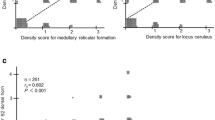Summary
The locus ceruleus was studied in 86 brains of the elderly, with or without degenerative disease. Parkinson's disease, multiple system atrophy, progressive supranuclear palsy and senile dementia were among the diseases studied. Nerve cell loss, the appearance of neurofibrillary changes and Lewy bodies were examined semi-quantiatively. The number of nerve cells diminished in old age, especially over 90 years. The decrease of nerve cells was greater in cases with Lewy bodies. A marked loss of nerve cell was observed in multiple system atrophies, including Shy-Drager syndrome, olivopontocerebellar atrophy and striatonigral degeneration, and in some cases of Parkinson's disease and senile dementia. The number of nerve cells did not decrease in cases of progressive supranuclear palsy. Lewy bodies and neurofibrillary tangles appeared increasingly in old age. However, the incidence of both changes in the same neuron was rare, and in such cases their structures appeared not to be related.
Zusammenfassung
Es wurden 24 Hirne von Individuen von über 60 Jahren untersucht sowie 22 Gehirne von Patienten mit Parkinsonscher Krankheit, multipler Systematrophie, seniler Demenz, progressiver supranukleärer Lähmung etc. Es wurden semiquantitative Untersuchungen über die Anzahl der Nervenzellen und das Auftreten der Neurofibrillenveränderungen und Lewyschen Körperchen im Locus ceruleus angestellt.
1. Die Durchschnittszahl der Nervenzellen im Locus ceruleus bei 60 Individuen von über 60 Jahren war geringer als jene bei 12 jüngeren Fällen. Besonders deutlich waren die zahlenmäßige Abnahme in den Fällen von über 90 Jahren. Das Volumen der Nervenzellen an Serienschnitten zeigte in den Fällen von über 80 Jahren einen Verlust von ca. 40%.
2. Der Verlust an Nervenzellen war besonders ausgeprägt bei jenen Fällen, die auch Lewy-Körperchen zeigten.
3. Ein besonders hochgradiger Verlust an Nervenzellen wurde in den Fällen mit multiplen Systematrophien, zum Beispiel Shy-Drager-Syndrom, olivo-ponto-cerebelläre Atrophie und striato-nigraler Degeneration sowie in einigen Fällen der Parkinsonschen Krankheit und senilen Demenz festgestellt. Andererseits war die Zahl der Nervenzellen in drei Fällen von progressiver supranukleärer Lähmung nicht vermindert.
4. Im hohen Alter waren die Lewyschen Körperchen und die Veränderungen der Neurofibrillen besonders ausgeprägt. Hingegen war das gleichzeitige Vorhandensein beider Veränderungen in ein und derselben Nervenzelle sehr selten und wenn dies einmal zusammen vorhanden war, war keine strukturelle Beziehung zwischen den zwei Veränderungen vorhanden.
Similar content being viewed by others
References
Alvord EC, Forno LS, Kusske LA, Kauffman RJ, Rhodes JS, Goetowski CR (1974) The pathology of parkinsonism: a comparison of degenerations in cerebral cortex and brainstem. Adv Neurol 5:175–193
Amaral DG, Sinnamon HM (1977) The locus coeruleus neurobiology of a central noradrenergic nucleus. Prog Neurobiol 9:147–196
Bergonzi P, Chiureulla C, Cianchetti C, Tempesta E (1974) Clinical pharmacology as an approach to the study of biochemical sleep mechanism: the action of L-DOPA. Conf Neurol 36:5–22
Brody H (1978) Cell counts in cerebral cortex and brainstem. In: Katzman R, Terry RD, Bick KL (eds) Alzheimer's disease: senile dementia and related disorders. Raven Press, New York, pp 345–351
Den Hartog Jager WA (1970) Histochemistry of adrenal bodies in Parkinson's disease. Arch Neurol 23:528–533
Feinberg I (1976) Functional implications of changes in sleep physiology with age. In: Terry RD, Gershon S (eds) Neurobiology of aging. Raven Press, New York, pp 23–41
Feinberg I, Braun M, Shulman E (1969) EEG sleep patterns in mental retardation. Electroencephalogr Clin Neurophysiol 27:128–141
Forno LS (1969) Concentric hyalin intraneuronal inclusions (50 incidental cases): relationship to parkinsonism. J Am Geriat Soc 17:557–575
Hirano A (1978) An outline of neuropathology. Igakushoin, Tokyo, p 52
Jellinger K, Grisold W (1982) Cerebral atrophy in Parkinson syndrome. Exp Brain Res [Suppl] 5:26–35
Leygonie F, Thomas J, Degos LD, Bouchareine A, Barbozet J (1976) Tubules du sommeil dans la maladie de Steele-Richardson. Rev Neurol (Paris) 132:125–136
Mann DMA, Lincoln J, Yates PO, Stamp JE, Toper S (1980) Changes in the monoamine containing neurones of the human CNS in senile dementia. Br J Psychiatry 136:533–541
Mann DMA, Yates PO, Hawkes J (1982) Plaques and tangles and transmitter deficiencies in dementia. J Neurol Neurosurg Psychiatry 45:563–564
Perry E, Tomlinson BE, Blessed G, Perry RH, Cross AJ, Crow TJ (1981) Neuropathological and biochemical observations on the noradrenergic system in Alzheimer's disease. J Neurol Sci 51:279–287
Tomlinson BE, Irving D, Blessed G (1981) Cell loss in the locus ceruleus in senile dementia of Alzheimer type. J Neurol Sci 49:419–428
Tomonaga M (1981) Neurofibrillary tangles and Lewy bodies in the locus ceruleus neurons of the aged brain. Acta Neuropathol 53:165–168
Tomonaga M, Yoshimura M, Shimada H, Kobayashi I (1977) Adrenal bodies observed in Shy-Drager syndrome. Neurol Med (Tokyo) 6:543–545
Vijayashankar N, Brody H (1978) A quantitative study of the pigmented neurones in the nuclei locus coeruleus and subcoeruleus in man as related to aging. J Neuropathol Exp Neurol 38:490–497
Yoshimura M (1983) Cortical changes in the parkinsonian brain: a contribution to the delineation of “diffuse Lewy body disease”. J Neurol 229:17–32
Author information
Authors and Affiliations
Rights and permissions
About this article
Cite this article
Tomonaga, M. Neuropathology of the locus ceruleus: a semi-quantitative study. J Neurol 230, 231–240 (1983). https://doi.org/10.1007/BF00313699
Received:
Issue Date:
DOI: https://doi.org/10.1007/BF00313699




